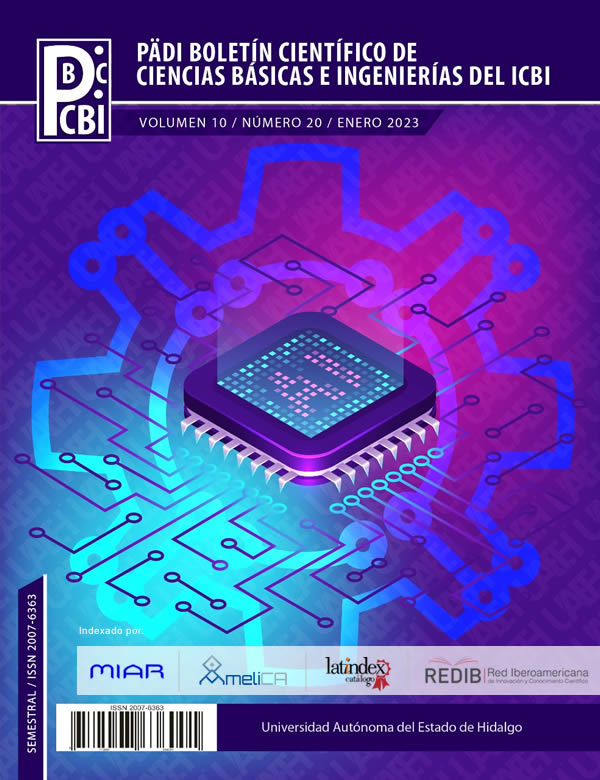Synthesis of luminescent carbon particles obtained by carbonization of Beta Vulgaris (beetroot) fruit
Abstract
An effective, economical and eco-friendly method was employed for synthesis of carbon quantum dots (CQDs) with emissive properties in blue colour by carbonization of beta vulgaris (beetroot) fruit. Experiments were made at different temperatures and carbonization times using water as a single solvent. The CQDs obtained exhibited fluorescence after being exposed to an ultraviolet radiation lamp with a wavelength of 254 nm and were analysed by Fourier transform infrared spectroscopy where carboxylates compounds were identified as a responsible for the surface passivation of the CQDs.
Downloads
References
An, Q., Lin, Q., Huang, X., Zhou, R., Guo, X., Xu, W., Wang, S., Xu, D., & Chang, H. T. (2021). Electrochemical synthesis of carbon dots with a Stokes shift of 309 nm for sensing of Fe3+ and ascorbic acid. Dyes and Pigments, 185(PA), 108878. https://doi.org/10.1016/j.dyepig.2020.108878
Baião, D. dos S., da Silva, D. V. T., & Paschoalin, V. M. F. (2020). Beetroot, a remarkable vegetable: Its nitrate and phytochemical contents can be adjusted in novel formulations to benefit health and support cardiovascular disease therapies. Antioxidants, 9(10), 1–36. https://doi.org/10.3390/antiox9100960
Cao, Y., Wang, X., Bai, H., Jia, P., Zhao, Y., Liu, Y., Wang, L., Zhuang, Y., & Yue, T. (2022). Fluorescent detection of tetracycline in foods based on carbon dots derived from natural red beet pigment. Lwt, 157, 113100. https://doi.org/10.1016/j.lwt.2022.113100
Chhikara, N., Kushwaha, K., Sharma, P., Gat, Y., & Panghal, A. (2019). Bioactive compounds of beetroot and utilization in food processing industry: A critical review. Food Chemistry, 272, 192–200. https://doi.org/10.1016/j.foodchem.2018.08.022
Clifford, T., Howatson, G., West, D. J., & Stevenson, E. J. (2015). The potential benefits of red beetroot supplementation in health and disease. Nutrients, 7(4), 2801–2822. https://doi.org/10.3390/nu7042801
Cui, L., Ren, X., Wang, J., & Sun, M. (2020). Synthesis of homogeneous carbon quantum dots by ultrafast dual-beam pulsed laser ablation for bioimaging. Materials Today Nano, 12, 100091. https://doi.org/10.1016/j.mtnano.2020.100091
El-Shabasy, R. M., Elsadek, M. F., Ahmed, B. M., Farahat, M. F., Mosleh, K. M., & Taher, M. M. (2021). Recent developments in carbon quantum dots: Properties, fabrication techniques, and bio-applications. Processes, 9(2), 1–24. https://doi.org/10.3390/pr9020388
Feng, X., & Zhang, Y. (2019). A simple and green synthesis of carbon quantum dots from coke for white light-emitting devices. RSC Advances, 9(58), 33789–33793. https://doi.org/10.1039/c9ra06946a
Jelinek, R. (2017). Carbon Quantum Dots. Synthesis, Properties and Applicatons. Springer. https://doi.org/10.1007/978-3-319-43911-2
Kurian, M., & Paul, A. (2021). Recent trends in the use of green sources for carbon dot synthesis–A short review. Carbon Trends, 3, 100032. https://doi.org/10.1016/j.cartre.2021.100032
Li, X. (2017). The Role of Functional Groups in Carbon Dots ’ Emission and Sensing Applications [Griffith University]. https://doi.org/doi.org/10.25904/1912/411
Lim, S. Y., Shen, W., & Gao, Z. (2015). Carbon quantum dots and their applications. Chemical Society Reviews, 44(1), 362–381. https://doi.org/10.1039/c4cs00269e
Luo, J., Sun, Z., Zhou, W., Mo, F., Wu, Z. chao, & Zhang, X. (2021). Hydrothermal synthesis of bright blue-emitting carbon dots for bioimaging and fluorescent determination of baicalein. Optical Materials, 113(December 2020), 110796. https://doi.org/10.1016/j.optmat.2020.110796
Ma, C., Yin, C., Fan, Y., Yang, X., & Zhou, X. (2019). Highly efficient synthesis of N-doped carbon dots with excellent stability through pyrolysis method. Journal of Materials Science, 54(13), 9372–9384. https://doi.org/10.1007/s10853-019-03585-7
Mancha Flores, M. A., Rentería Monterrubio, A. L., Sánchez Vega, R., & Chávez Martínez, A. (2019). ESTRUCTURA Y ESTABILIDAD DE LAS BETALAÍNAS. Interciencia, 44(6), 318–325. https://www.redalyc.org/articulo.oa?id=33960068002
Nasrollahzadeh, M., Sajjadi, M., & Sajadi, S. M. (2019). Green Nanotechnology. In An Introduction to Green Nanotechnology (1st ed., Vol. 28, pp. 145–198). Elsevier Ltd. https://doi.org/10.1016/B978-0-12-813586-0.00005-5
Neagu, C., & Barbu, V. (2014). Principal component analysis of the factors involved in the extraction of beetroot betalains. Journal of Agroalimentary Processes and Technologies, 20(4), 311–318.
Perumal, S., Atchudan, R., Edison, T. N. J. I., & Lee, Y. R. (2021). Sustainable synthesis of multifunctional carbon dots using biomass and their applications: A mini-review. Journal of Environmental Chemical Engineering, 9(4), 105802. https://doi.org/10.1016/j.jece.2021.105802
Wang, Y., & Hu, A. (2014). Carbon quantum dots: Synthesis, properties and applications. Journal of Materials Chemistry C, 2(34), 6921–6939. https://doi.org/10.1039/c4tc00988f
Zhao, D., Liu, X., Wei, C., Qu, Y., Xiao, X., & Cheng, H. (2019). One-step synthesis of red-emitting carbon dots: Via a solvothermal method and its application in the detection of methylene blue. RSC Advances, 9(51), 29533–29540. https://doi.org/10.1039/c9ra05570c













